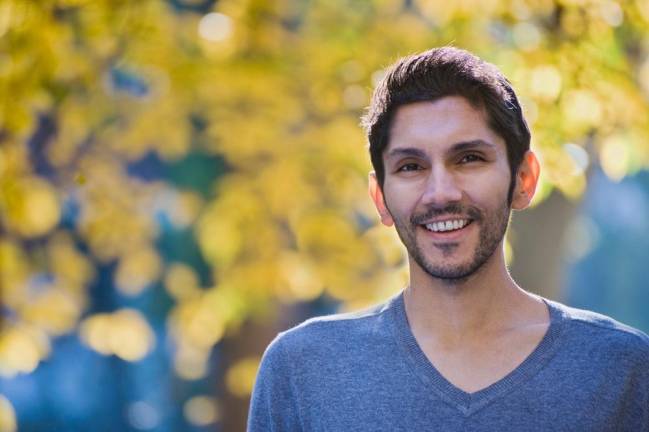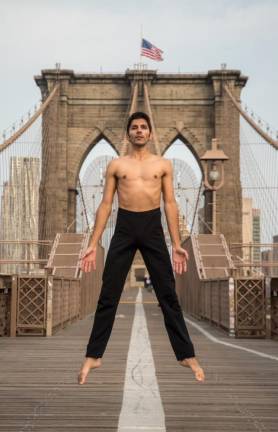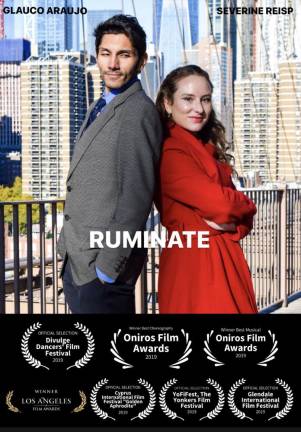The Universal Language of the Arts
Dancer and actor Glauco Araujo on living his American Dream

Glauco Araujo in Madison Square Park. Photo: Leland Bobbé


When Glauco Araujo first arrived in the States, he communicated through dance since he did not yet speak English. And it was actually the Chicago dance company he was in at the time that helped him learn the language. In its library, the Brazilian native read books about the craft he was so passionate about, painstakingly going page by page with his Google Translate app. “I literally learned English like that,” he explained. “It was a book about the founders of Modern Dance — dancers like Isadora Duncan, Ruth St. Denis, Ted Shawn, Martha Graham and Doris Humphrey. I also read a lot of biographies about the stars of the Golden Age of Hollywood.”
Before that stint in the Windy City, the current Yorkville resident bravely came to the Big Apple alone at 26 to study modern dance at the Martha Graham School. Two years later, he returned to pursue a scholarship with The Ailey School. Since his not-so-humble beginnings in the New York dance world, he broke into both the screen and stage scenes in the city, landing roles in TV shows, short films and commercials, and later, off-Broadway plays. As for his future plans, the 32-year-old said, “I hope that wherever I go, or wherever job I take on, it will move me forward as an actor, dancer and human being.”
When did you first start dancing and acting professionally in New York?
I think I was at Alvin Ailey for two or three months and then I got this opportunity to dance with the Camerata New York Orchestra. So that was the beginning, and after that, I started dancing in TV shows. And then after that, I started getting parts in films. It didn’t take too long, thank God. [Laughs]
What was your first big role in film?
The first film I did was an independent film called “Ruminate.” It was a short film with dance. It was a romantic film. This was my first one that actually was out there.
And in theater?
My debut was with a theater company on the Upper East Side called Triangle Theatre Company. So I did the lead in the show “Forty Carats.” It was my first play actually here in the U.S. in English. So I was so afraid, because I had a big part. But at that point, my English was better. I was here for a few years. But still, I was so nervous. [Laughs]
Is any of your family here?
No, I’m by myself here. My whole family’s in Brazil. I was the brave one.
Have they ever come to see your shows?
Not yet. We’re planning, but with the pandemic and everything...
The film you made, “Adrift,” was recorded during the pandemic. How did your part in that come about?
It was an invitation that came from the president of the Episcopal Actors Guild. They were raising money to help artists, people who are in difficult situations who can’t afford to pay the rent or don’t have food. The organization actually helped those artists. So he asked me if I wanted to perform with them to raise money for the organization. So I said, “Of course, yes.” And then I learned, later on, there was Anthony Newfield and Alison Fraser from Broadway [in it], and Karen Archer from the West End in London and also the writer was actually Richard Alleman, who was [an] editor of Vogue magazine.
How has your job changed during COVID?
The beginning was quite painful because everything was closed and we didn’t know what the disease was and what was going to happen. I got the virus by the end of March. Right in the beginning when they started closing everything, I started having the symptoms. And back then, we didn’t know if I had the virus or not, because they didn’t have a test. I was sick for at least two weeks, but it was a mild case and I did fine, thank God. Because I’m in touch with a lot of the film schools in New York, and since I was home and everything was done by Zoom, I had a few friends who called me, saying, “Oh, I need an actor, please.” So it was nice to do something in that period because there was no work. And then after that, that’s when we did “Adrift.” And then, because it was summer, they were able to film outside in the park, and I was able to do small projects. And then we did “Dance for Freedom,” that was another short film ... It is about people of color. The director, Severine Reisp, is my friend and she called and asked me if I was comfortable sharing things about myself. We did the film and she put it in the Dr. David Milch Foundation/CCNY Short Film Competition and got the first place.
Tell us about the roles you had off Broadway.
I had one in a show called “Come Back Once More So I Can Say Goodbye,” that was for the 50th anniversary of Stonewall, in the summer of 2019. And the other one was “A Crossing,” that I did with Barrington Stage Company. It was about Mexicans crossing the border and coming illegally to the U.S. It’s not a pleasant story for a musical, but it’s beautiful, the way they did the music. It’s very meaningful. They were able to involve a folk dance company from Mexico. They taught us specific steps. I’m from Brazil, so didn’t know much about Mexican culture, so it was nice to learn, especially dance. It was going to Broadway, but because of the pandemic...We were going to go first to Boston, and then they would bring it to New York.
What is a Broadway role you would want one day?
Definitely something that involves dance and lots of high energy. Maybe even a performance — it doesn’t have to be a musical — but something real and original, that people relate to quickly and is not too difficult to understand. That as soon as you watch it, you say, “Oh my gosh, I feel so attached to this.”
Tell us about your experience performing with a disabled dance company. Through it, you represented Brazil in the Paralympics.
Right in the beginning, as a dancer, I got this opportunity to start doing disabled dance with people in wheelchairs. The company was called Corpo em Movimento. It is a dance company with people in wheelchairs and able-bodied people. Usually, the normal way you start as a dancer is you take a ballet or jazz class, and then you evolve and start doing other styles. So I started totally opposite, it’s very unusual, with disabled dance. And then I was able to do ballet and modern and find other ways. That was actually my first experience and the one that taught me a lot about life. It shaped me. The Paralympics committee invited Corpo em Movimento to perform and represent Brazil in the ceremony in London. It was an incredible experience. First, I was in London for the first time, what an amazing city. And I was chosen to perform with amazing and talented artists in an international event. I met athletes from Spain, Canada, Germany and France, and it was more than I could have ever wished for. The experience enriched my worldview.
www.glaucoaraujo.com